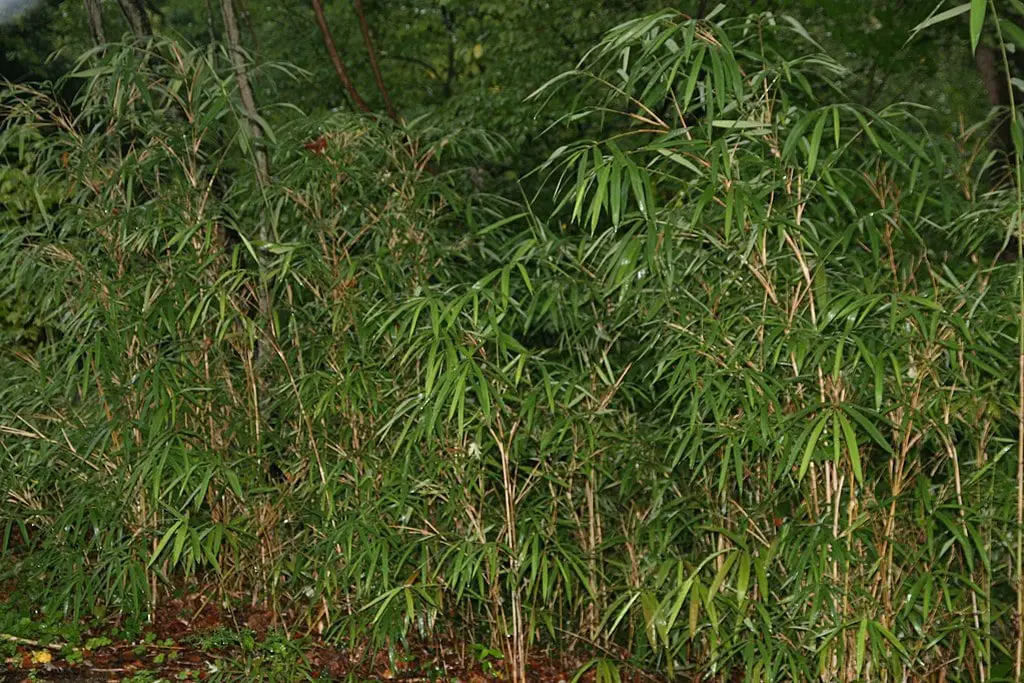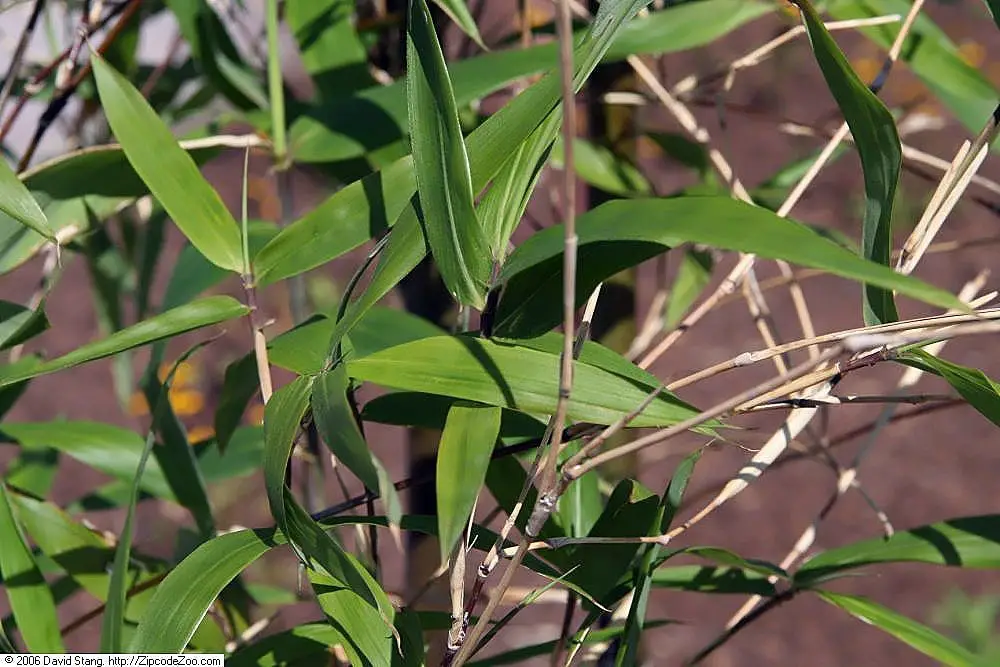Key Takeaways
-
Arundinaria gigantea, or Giant Cane, is a tall perennial bamboo-like grass native to North America.
-
It is perfect for creating privacy screens in gardens and can tolerate various climate zones.
-
Arundinaria gigantea thrives in moist soil conditions and can tolerate full sun or partial shade.
-
It has multiple uses, including erosion control, biofuel production, wildlife habitat, and construction material.
Key Facts
|
Attribute |
Detail |
|
Common names |
Giant Cane, River Cane, Switch Cane |
|
Type |
Running |
|
Height |
Up to 30 feet |
|
Culm (stem) diameter |
Up to 2 inches |
|
USDA hardiness zones |
5-9 |
|
Minimum temperature |
-20°F |
|
Light requirements |
Full sun to partial shade |
|
Soil requirements |
Moist, well-drained soil |
|
Watering requirements |
Regular watering, more in dry conditions |
|
Best for |
Screening, hedges, windbreaks, erosion control |
Characteristics of Arundinaria gigantea
You’ll be amazed at the tall and sturdy nature of Arundinaria gigantea, making it a perfect choice for creating privacy screens in your garden.
This species is a perennial grass that can reach impressive heights of up to 30 feet. Its erect culms are characterized by a strong and robust structure, providing excellent support for its dense foliage.
The leaves are long and narrow, measuring around 1 inch in width and up to 6 inches in length. They have a dark green coloration with a glossy texture, adding an elegant touch to any landscape.
Arundinaria gigantea thrives in moist soil conditions and can tolerate both full sun and partial shade. Additionally, this species is highly adaptable to various climate zones, from the southern United States all the way up to Canada.
With its remarkable height and resilience, Arundinaria gigantea is truly an impressive plant for creating privacy screens while adding beauty to your garden landscape.
Choosing the Right Location for Planting
Selecting the ideal location involves considering various factors, such as sunlight exposure and soil conditions. To ensure the successful growth of Arundinaria gigantea, here are five important aspects to keep in mind:
-
Sunlight: Choose a location that receives full to partial sun throughout the day.
-
Soil: Opt for well-drained soil with a pH level ranging from slightly acidic to slightly alkaline.
-
Moisture: While Arundinaria gigantea can tolerate both wet and dry conditions, it thrives in consistently moist soil.
-
Space: Make sure you have enough space for the bamboo to spread, as it can grow up to 20 feet tall and form dense clumps.
-
Protection: Consider planting near a windbreak or providing some form of protection from strong winds, which can damage the delicate foliage.
By carefully selecting the right location based on these considerations, you can create an optimal environment for your Arundinaria gigantea plants to flourish.
Planting and Propagation Techniques
Once you’ve found the perfect location, it’s time to get your hands dirty and start planting and propagating your bamboo. Arundinaria gigantea can be propagated through both seeds and rhizomes. Seeds should be collected from mature plants and sown in a well-draining potting mix. Keep the soil consistently moist until germination occurs, which usually takes about 3-4 weeks.

Rhizome division is another common method of propagation. Dig up an established clump of bamboo and carefully separate the rhizomes using a sharp knife or spade, making sure each division has several nodes. Plant these divisions at the same depth as they were originally growing, spacing them apart to allow room for growth. Water thoroughly after planting and keep the soil evenly moist during the establishment period.
|
Propagation Method |
Steps |
|
Seed Propagation |
– Collect seeds from mature plants – Sow in well-draining potting mix – Keep soil consistently moist until germination occurs |
|
Rhizome Division |
– Dig up established clump of bamboo – Carefully separate rhizomes with sharp knife or spade – Ensure each division has several nodes – Plant divisions at original depth, spacing them apart for growth – Water thoroughly and keep soil evenly moist during establishment period |
Caring for Arundinaria gigantea
To ensure the healthy growth of your bamboo, it’s important to provide regular watering and a balanced fertilizer. Arundinaria gigantea requires consistent moisture in the soil, so make sure to water it deeply at least once a week, especially during dry periods. Avoid overwatering as this can lead to root rot.
Additionally, applying a balanced fertilizer with equal amounts of nitrogen, phosphorus, and potassium will promote vigorous growth and overall plant health. Spread the fertilizer evenly around the base of the plant and water it in thoroughly afterwards.
The following practises are also recommended:
-
Mulch: Apply a thick layer of organic mulch around the bamboo to help retain moisture in the soil and suppress weed growth.
-
Pruning: Regularly remove any dead or damaged canes to maintain an attractive appearance and encourage new growth.
-
Winter protection: In colder climates, protect arundinaria gigantea by covering it with burlap or straw during winter months to prevent frost damage.
By following these care guidelines, you can ensure that your arundinaria gigantea thrives and remains a beautiful addition to your garden or landscape.
Practical Uses and Benefits of Giant Cane
This versatile plant has a wide range of applications, making it a valuable addition to your garden or landscape. One of the main uses of Giant Cane is in erosion control. Its extensive root system helps stabilize soil and prevent erosion, especially on slopes or near water bodies.
Additionally, this plant can be used for biofuel production due to its high biomass yield and fast growth rate. The table below illustrates some other practical uses and benefits of Giant Cane:
|
Practical Uses |
Benefits |
|
Privacy screening |
Provides a natural barrier |
|
Wildlife habitat |
Attracts various species of birds and insects |
|
Construction material |
Can be used for fencing, thatching, or crafting |
|
Phytoremediation |
Absorbs pollutants from soil and water |
|
Carbon sequestration |
Helps reduce greenhouse gas emissions |
By incorporating Giant Cane into your landscape, you can enjoy these practical uses while contributing to environmental sustainability.



Photo by David J. Stang, CC BY-SA 4.0 via Wikimedia Commons
Frequently Asked Questions
Q: What is Arundinaria gigantea?
Arundinaria gigantea, also known as Giant Cane, is a species of bamboo native to the southeastern United States.
Q: What are some other names for Arundinaria gigantea?
Arundinaria gigantea is also commonly referred to as giant cane, river cane, canebreak bamboo, and native cane.
Q: What kind of plant is Arundinaria gigantea?
A: Arundinaria gigantea is a native, tall, and fast-growing perennial bamboo plant.
Q: Where does Arundinaria gigantea grow?
A: Arundinaria gigantea predominantly grows in wet areas such as swamps, bottomlands, and floodplains.
Q: Is Arundinaria gigantea an evergreen plant?
A: Yes, Arundinaria gigantea is an evergreen plant, meaning it retains its green foliage throughout the year.
Q: Why is Arundinaria gigantea important?
A: Arundinaria gigantea, is an important plant species as it forms dense stands called canebrakes, providing habitat for various wildlife including the Bachman’s warbler and the southern pearly-eye butterfly. It also has historical and cultural significance in basketry and as a food source for native populations.
Q: Is Arundinaria gigantea invasive?
A: No, Arundinaria gigantea is a native plant and is not considered invasive.
Q: How does Arundinaria gigantea reproduce?
A: Arundinaria gigantea reproduces by seeds and by underground rhizomes that spread to form new shoots.
Q: How tall does Arundinaria gigantea grow?
A: Arundinaria gigantea can grow up to 20 feet tall, forming dense stands of cane along the gulf coast, covering thousands of acres.
Q: How can Arundinaria gigantea be managed?
A: Arundinaria gigantea can be managed through cutting and periodic burning, as well as through careful control of its spread in certain plant communities.
Conclusion
Arundinaria gigantea is a remarkable plant with various practical uses and benefits. Its characteristics make it an ideal choice for landscaping projects or erosion control efforts. By choosing the right location and employing proper planting and propagation techniques, you can successfully grow this versatile plant.
Caring for Arundinaria gigantea requires regular maintenance such as watering and pruning. With its ability to provide habitat for wildlife and prevent soil erosion, the giant cane is a valuable addition to any garden or natural landscape.
*Feature image by David J. Stang, CC BY-SA 4.0 via Wikimedia Commons

